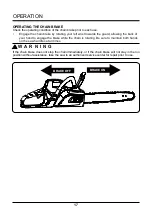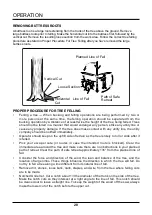
5
IMPORTANT SAfETY INSTRUCTIONS
SPECIFIC SAFETY WARNINGS
• Keep all parts of the body away from the saw chain when the chainsaw is operating.
Before you start the chainsaw, make sure the saw chain is not contacting anything.
A
moment of inattention while operating chainsaws may cause entanglement of your clothing or
body with the saw chain.
• Always hold the chainsaw with your right hand on the rear handle and your left hand on
the front handle.
Holding the chainsaw with a reversed hand configuration increases the risk of
personal injury and should never be done.
• Hold the chainsaw by insulated gripping surfaces only, because the saw chain may
contact hidden wiring.
Saw chains contacting a “live” wire may make exposed metal parts of
the chainsaw “live” and could give the operator an electric shock.
• Always use two hands when operating the chainsaw.
Contact of the guide-bar tip with any
object should be avoided.
• Tip contact may cause the guide bar to move suddenly upward and backward, which may
cause serious injury.
• Wear safety glasses and hearing protection. Further protective equipment for the head,
hands, legs, and feet is recommended.
Adequate protective clothing will reduce personal
injury by flying debris or accidental contact with the saw chain.
• Do not operate a chainsaw in a tree.
Operation of a chainsaw while up in a tree may result in
personal injury.
• Always keep proper footing and operate the chainsaw only when standing on fixed,
secure and level surface.
Slippery or unstable surfaces such as ladders may cause a loss of
balance or control of the chainsaw.
• When cutting a limb that is under tension, be alert for spring back.
When the tension in
the wood fibers is released, the spring loaded limb may strike the operator and/or throw the
chainsaw out of control.
• Use extreme caution when cutting brush and saplings.
The slender material may catch the
saw chain and be whipped toward you or pull you off balance.
• Carry the chainsaw by the front handle with the chainsaw switched off and away from
your body. When transporting or storing the chainsaw always put on the scabbard.
Proper
handling of the chainsaw will reduce the likelihood of accidental contact with the moving saw
chain.
• Follow instructions for lubricating, chain tensioning, and changing accessories.
Improperly tensioned or lubricated chain may either break or increase the chance for kickback.
• Keep handles dry, clean, and free from oil and grease.
Greasy, oily handles are slippery
which can cause loss of control.
• Cut wood only. Do not use chainsaw for purposes not intended. For example: do not
use chainsaw for cutting plastic, masonry, or non-wood building materials.
Use of the
chainsaw for operations different than intended could result in a hazardous situation.
Summary of Contents for CS60L00
Page 40: ...40 EXPLODED VIEW ...
































